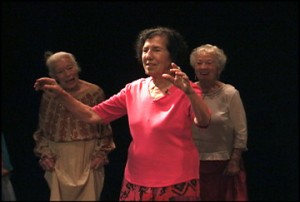 Miriam Rochlin was born in Bonn in 1920 and she died last week in Los Angeles, a huge lifetime later. I knew Miriam only slightly, but knowing her at all was a great privilege.
Miriam Rochlin was born in Bonn in 1920 and she died last week in Los Angeles, a huge lifetime later. I knew Miriam only slightly, but knowing her at all was a great privilege.
Choreographer Karen Goodman, pictured below chatting with her, knew the incandescent dancer well. The film, “Come Let Us Dance,” directed by Karen features Miriam teaching Yiddish dance.
Only breaking her collar bone in a car accident at age 66 caused Miriam to cut back on doing cartwheels and handstands — and walking on her hands — on the beach. But she taught dance till she was 90.
“My attitude is to assume from the beginning that everyone is beautiful. Isn’t that marvelous? Fly out! Fly out!” said Miriam, according to Karen.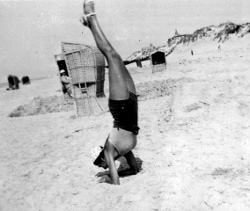
Reprinted, with permission, from “REAPPEARING ACTS: From Jewish Life to Jewish Dance Theater,” an essay that addresses Miriam’s background and her contribution to Yiddish dance theater, along with fellow Jewish exiles, Nathan Vizonsky and Benjamin Zemach.
Miriam Rochlin’s paternal grandfather, Bernhard Cohn, was an assimilated doctor until an anti-Semitic smear campaign. In 1896, he published, almost simultaneously to Herzl, a pamphlet titled Before the Storm: A Serious Warning to the Jews of Germany. The family became important Zionist activists and most of his children immigrated to Palestine in the 1920’s, except for his son Rabbi Cohn [Miriam’s father] and family. Because of his commitments to his congregation and to speaking out against the Nazis, he remained longer.
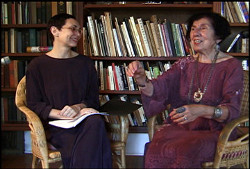 The Cohns’ friends included poet Elsa Lasker-Shuler and Catholic opera star Henny Wolf, who was called “aunt” by the children. Stage and film actor Alexander Granach was “uncle.” Miriam’s mother’s mother remained a successful banker after her husband’s death and was the only female member of a poker club in Muelheim/Ruhr. Her cousin married Gurit Kadman, the mother of Israeli folk dance. Everything was discussed at the dinner table: art, religion, love affairs, sexual preferences of friends. But the dinner was kosher and blessings said.
The Cohns’ friends included poet Elsa Lasker-Shuler and Catholic opera star Henny Wolf, who was called “aunt” by the children. Stage and film actor Alexander Granach was “uncle.” Miriam’s mother’s mother remained a successful banker after her husband’s death and was the only female member of a poker club in Muelheim/Ruhr. Her cousin married Gurit Kadman, the mother of Israeli folk dance. Everything was discussed at the dinner table: art, religion, love affairs, sexual preferences of friends. But the dinner was kosher and blessings said.
For about a year, when Miriam was 10, she and her father spent time every day translating Genesis from Hebrew to German. As Miriam explained this two-sided identity, “We were quick-change artists.”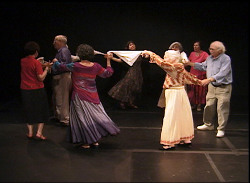
Inspired to choreograph after seeing her first ballet at age six, she studied ballet and interpretive dance. She saw famous Expressionist dancers and Hollywood musicals. In 1933, the Nazis required Jews to attend Jewish schools only. In 1934, she applied for teacher certification in dance at a German institute, which would take her only under another name. Her mother refused. She was taken into the Juta Klamt Institute, but could only afford one day a week. After her second class, Juta’s husband, in the Nazi hierarchy, told her she could come every day at no extra charge, which she did for 2 years until it became too dangerous. She attended another an institute, taught by a Russian émigré, training in modern, ballet, anatomy and kinesiology. In January, 1937, she received her diploma, and left for Holland with her father.
Following her family to San Francisco, it took three years to finally start taking 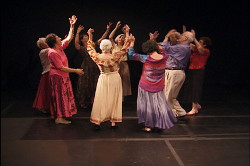 dance class again. She worked with Benjamin Zemach for 20 years as his assistant and in both his dance and theater companies. She taught dance and drama for Jewish schools and for the city school system’s Adult Schools. She taught Confluent Education at Hebrew Union College, using movement, art and music to teach the Bible Through Improvisation, and the same class at a Catholic high school. In 1971, she choreographed The Dybbuk for USC, and in the 1980’s, Miriam led pre-performance discussions for a major L.A. production of The Dybbuk.
dance class again. She worked with Benjamin Zemach for 20 years as his assistant and in both his dance and theater companies. She taught dance and drama for Jewish schools and for the city school system’s Adult Schools. She taught Confluent Education at Hebrew Union College, using movement, art and music to teach the Bible Through Improvisation, and the same class at a Catholic high school. In 1971, she choreographed The Dybbuk for USC, and in the 1980’s, Miriam led pre-performance discussions for a major L.A. production of The Dybbuk.
In 1986, she showed “The Art of Benjamin Zemach” at the 92nd St. Y for the conference Jews and Judaism in Dance. This important document is the only film of [Zemach] dancing, with dances dating back to early 1920’s Moscow and circa 1930 New York.
Photos thank you, Karen Goodman, comeletusdance

My husband, Ali and I, met Miriam and her husband on a bus tour of Andalusia in the 1980s. My husband was born a Druze in Lebanon and I in the United States. We lived in Marin County but worked in Saudi Arabia. Something broke the ice of being strangers and we began to talk with them. We chatted about the history of Spain and the role of the Arabs and Jews in shaping Granada, Cordoba. and Seville. We spoke of a time in Spain of blended cultural attributes. Miriam spoke of peace in the Middle East and sincerely convinced me it is possible. She told us to be aware of politicians and promises based on extreme ideology.I have remembered her advice and adhered to it ever since. She knew firsthand of which she spoke. I only knew a little of her career and passion for dance, music and the stage but realized her dance background and my mother’s overlapped a tiny bit as my mother studied with Ruth St.Denis in Los Angeles many years ago. Miriam was kind beyond measure. She was attentive and loving and unforgettable. She impressed on us what identified with her skin color,dark eyes and hair, so gypsy-like. They matched her spirit while she was with us on earth. So fly, Miriam, and look down on us with those beautifuldark eyes. It is lonely and a bit frightening without you.
Thank you for sharing Naomi. We look forward to hearing how your amazing Times Square Project goes.
Miriam taught me exercises 15 years ago which I still teach in my classes for seniors today. Miriam was our oldest princess in a production of 12 Dancing Princesses with my company LAMD&B at the Ford Amphitheater in 1998. She was one of my richest inspirations of how an older body and move and be moving in her clarity. Her movements from her face to her hips, the grace of her port de bra is imprinted in my mind.
She taught me to go slowly with the students but always keep the rhythm going. In 2005, we visited in her home, shared class techniques and music. She told me to get the “Hooked On” recordings to play in my classes. A continuous medley of great hits telling me “the class will love it.” She was right.
That Miriam was such a well-known dancer, I didn’t know. Or that her family had such an arts and culture background. The Miriam I knew was the mother of my friend and colleague Joel; she was a lovely woman with a brilliant smile who made every gathering she was part of more lively and more fun. She was someone I laughed with, someone I listened to, someone I once startled by putting peanut butter on my bagel instead of the available lox. She was open and joyous and I loved knowing she was in the world. That she will be missed is a given.
Great article which taught me a lot more about Miriam. We spend many a time talking together and I miss holding her hand and seeing her wonderful smile . Her eyes always had the crystalized joy and beauty of understanding and kindness.
What a wonderful tribute to Aunt Miriam! There is so much to know about her…she was always so kind to me. I will sincerely miss her.